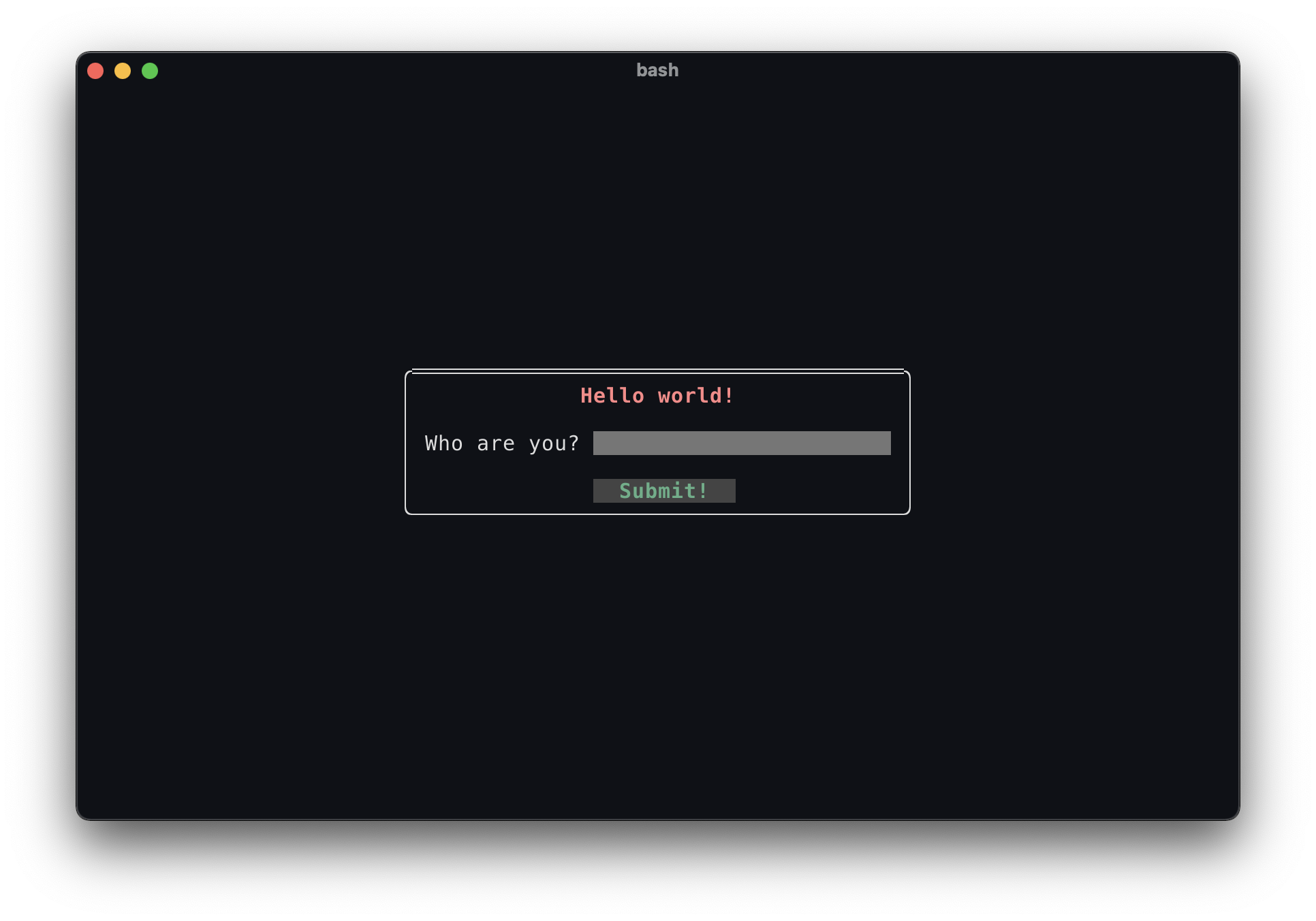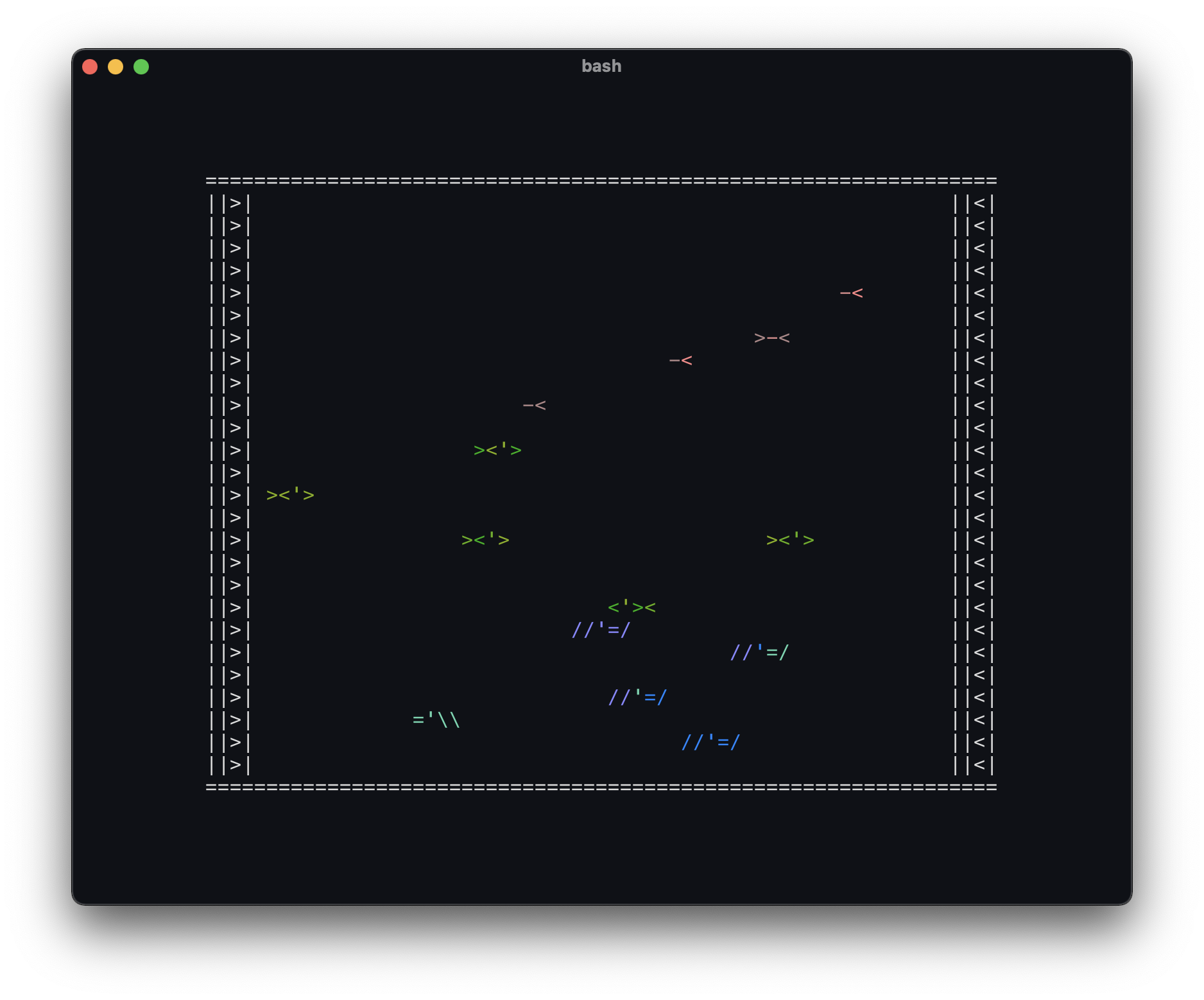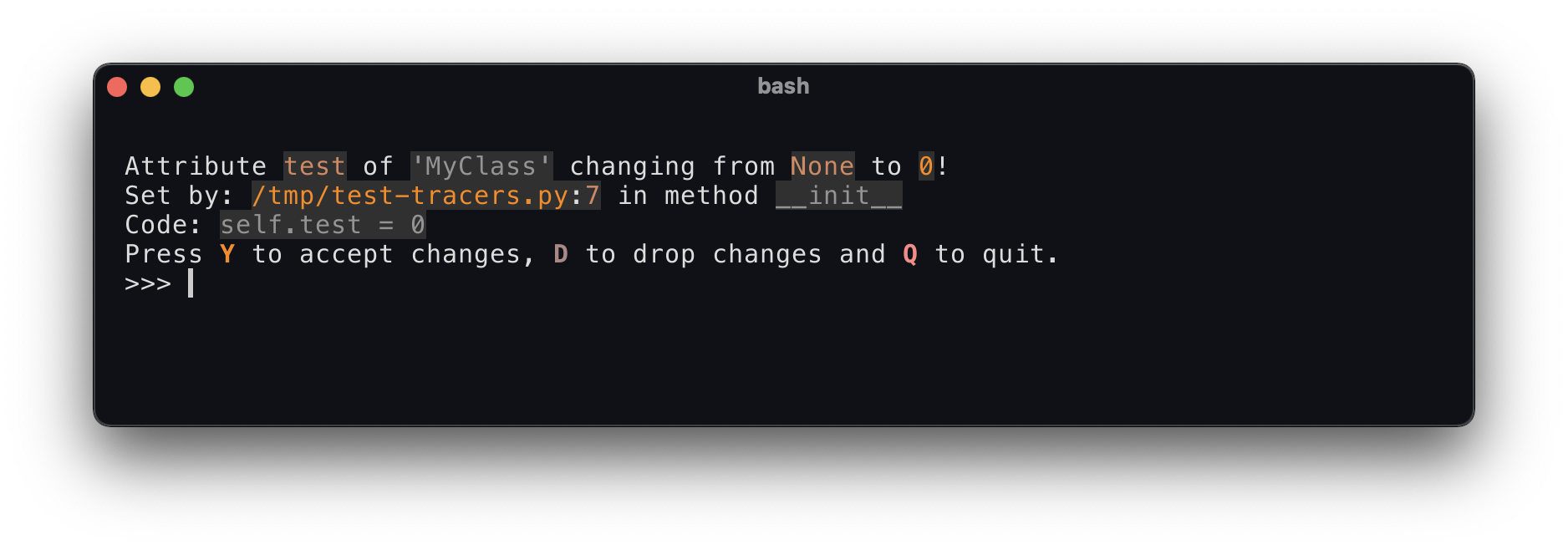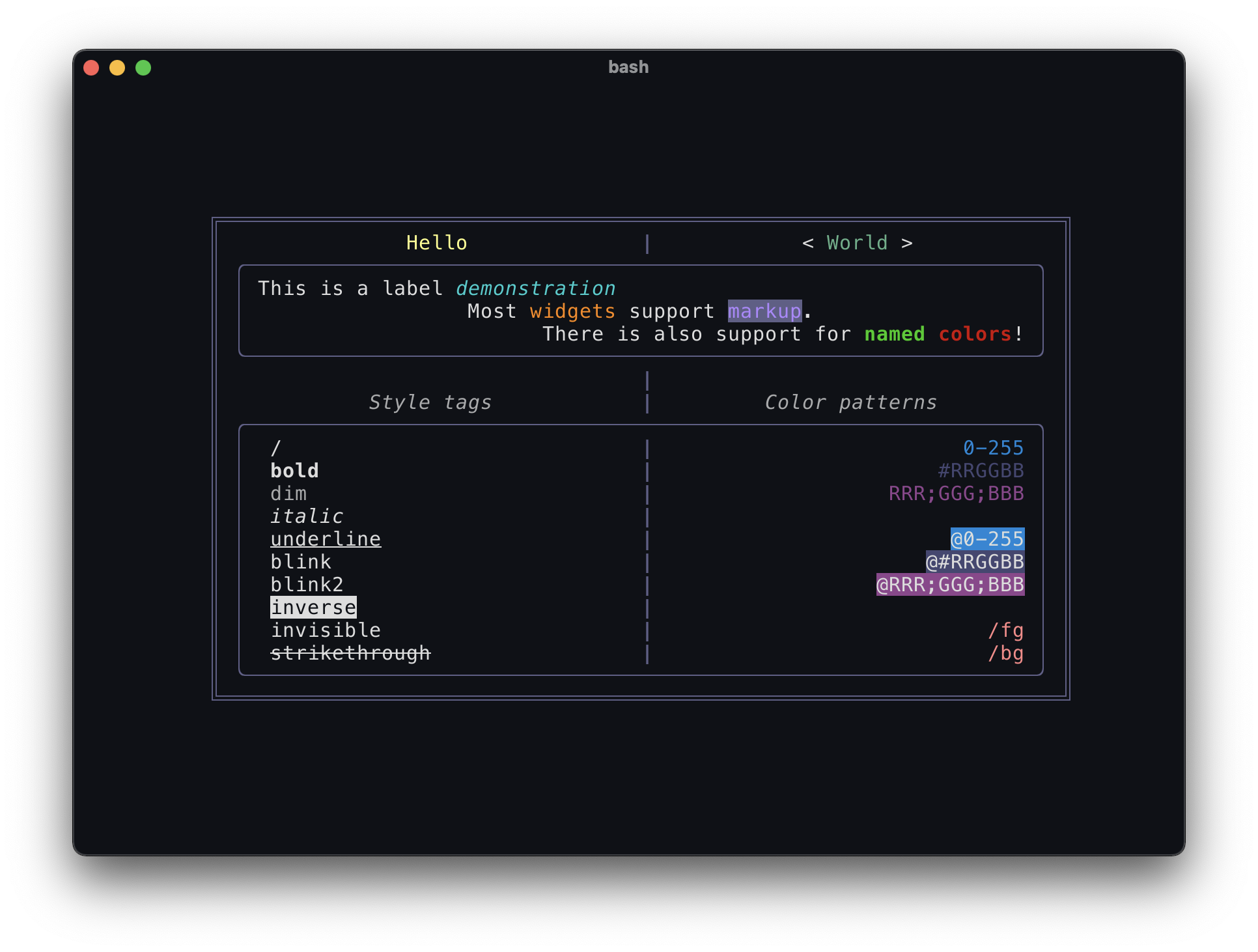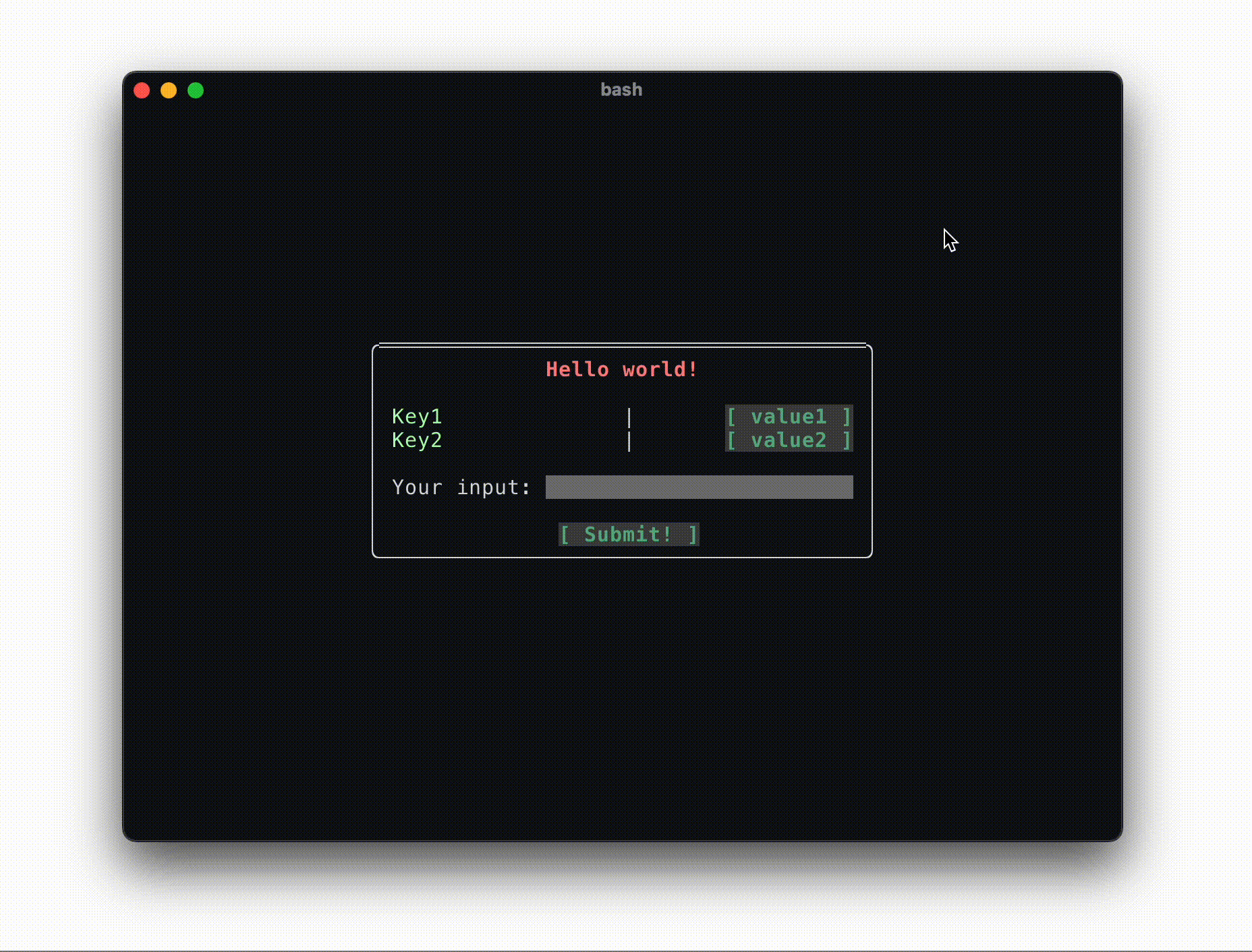A simple and robust terminal UI library, written in Python.
Project description
A simple yet powerful TUI framework for your Python (3.7+) applications
pip3 install pytermgui
Usecases
PyTermGUI can be used for a variety of things. You are ought to find something useful, whether you are after a TUI library with a mature widget API, a way to easily color and style your program's output or even just get syntax highlighting in the REPL.
Interfacing with the terminal
At its core, PyTermGUI is based on the ANSI interface module to provide pretty much all of the raw terminal capabilities. If you just want easy, Pythonic access to these APIs ansi_interface was made just for you!
from pytermgui import print_to, report_cursor, bold
print_to((10, 5), "12345"); report_cursor()

Using TIM to style your program's output
TIM, our Terminal Inline Markup language provides an easy to read, semantic and performant way to style your text. It is also modular and extensible, supports macros, in-terminal hyperlinks, all commonly used ANSI styles & colors, RGB & HEX and more!
from pytermgui import tim
tim.print("[dim italic]Welcome to [/dim /italic bold !rainbow]PyTermGUI"))
tim.print("Check out the [blue !link(https://ptg.bczsalba.com)]docs[/!link /fg]!"))
In this demo, clicking docs will bring you to the documentation.
Prettification
You can prettify all REPL output using just one line of code! It supports various datatypes, automatic printing of PyTermGUI and Rich objects and more!
Under the hood it calls tim.setup_displayhook() with no arguments. For more granular control, including flattening structures and customizing the colors, check out the TIM docs!
>>> from pytermgui import pretty
>>> ["Welcome to PyTermGUI!", {0: "Things are now", 1: "Prettier!"}, locals()]
>>> '[dim]TIM [/dim]code is automatically [!gradient(222)]syntax-highlighted'
Code-introspection
PyTermGUI offers an Inspector widget, as well as a higher level wrapper function, inspect that can be used to see detailed & pretty information on any Python object, including its documentation, methods, clickable hyperlink to its source & more!
>>> from pytermgui import inspect, Container
>>> inspect(Container.scroll_end)
See the docs or inspect(inspect) for more info!
Fully featured TUIs
You can check out an example TUI built into the library itself using the ptg command! It features some utility applications for PyTermGUI, such as an xterm-256 colorpicker, a TIM sandbox and a simple key-getter.
You can also follow a how-to guide on creating a simple application in the docs.
Our WindowManager implementation lets you create desktop-like interfaces, including mouse support, draggable, resizable and fullscreen-capable windows, animations and more!
No constraints
This library was built with the goal of allowing the most amount of customizability at each step of the process. This is due to my own personal experience with other similar projects, where I felt too confined into a certain program-architecture, way to express colors and the like. PyTermGUI aims to shed all of those limits to truly put you in control.
For example, you can define a Window in a couple of ways:
Instantiating it with its children as the arguments
# -- demo.py --
import pytermgui as ptg
with ptg.WindowManager() as manager:
demo = ptg.Window(
ptg.Label("[210 bold]Hello world!"),
ptg.Label(),
ptg.InputField(prompt="Who are you?"),
ptg.Label(),
ptg.Button("Submit!")
)
manager.add(demo)
manager.run()
Converting builtin datatypes into widgets
# -- demo.py --
import pytermgui as ptg
with ptg.WindowManager() as manager:
demo = (
ptg.Window()
+ "[210 bold]Hello world!"
+ ""
+ ptg.InputField(prompt="Who are you?")
+ ""
+ ["Submit!"]
)
manager.add(demo)
manager.run()
Definining the whole thing in YAML
Note that for YAML functionality the optional PyYAML dependency is required.
# -- demo.yaml --
widgets:
demo:
type: Window
widgets:
- Label:
value: "[210 bold]Hello world!"
- Label: {}
- InputField:
prompt: Who are you?
- Label: {}
- Button:
label: Submit!
# Run `ptg -f demo.yaml` to interpret this file
These all give you the exact same result, while allowing you to pick the best syntax for each case. I personally find YAML to be a great way to prototype complex widget layouts without having to write any driving code.
For completeness' sake, here is the Window we just created:
The ptg command line utility
As mentioned above, the ptg CLI tool is a great example for both the capabilities of the library and how to make use of it. It also provides some simpler helpers, such as --size to retrieve your terminal dimensions, and the --file argument which allows you to load and play around with a PTG YAML file.
Documentation!
Every single public and non-public name in the library is full documented, using Google's docstring style. If you ever have questions about the library, the documentation should have your answers.
Contributions welcome!
PyTermGUI will only become its best self if its users have their say. As such, we provide a contribution guide and are open to issues, suggestions and PRs!
All input is appreciated.
Some projects using PyTermGUI
We take pride in seeing others use the library. If you have a project you'd like us to add here, create a PR!
| Project name | Project description | Demo image |
|---|---|---|
sipedon |
An interactive aquarium for your terminal. | |
tracers |
Easily debug and trace attribute changes in your Python classes |
Examples
The examples/ directory contains some nice showcases of the library. Here are some of them:
Click on each image to see their source code
A hello world program
The TIM playground app
Note: Use
ptg --markappto try
A simple window manager demo in 13 lines of code, lifted from the docs
Projects to check out
The TUI game has been heating up as of recent. Here are some other interesting projects in the sphere:
- Winman - A window-manager add-on to the golang library tview. This project was a big inspiration for that specific aspect of PyTermGUI.
- Rich & Textual - Another Python-based set of TUI libraries. Some of the Rich markup syntax & code was used as inspiration for our own.
- pyTermTk - Name and functionality sibling of this project. Great TUI library if you are after tkinter/qt5 mimicking API.
- Jexer - One of the most insane-looking TUI libraries out there. Supports practically everything the terminal can do. I became aware of this project relatively recently, but it's been of great inspiration.
- notcurses - Another ridiculously powerful TUI library. Well worth installing and checking out the examples provided.
Consider donating
PyTermGUI takes up pretty much all of my freetime outside of work and university. Donations are always invested back into the project in some way, be it for better equipment or just extra motivation to continue working on it.
Do note that functionality will never be limited behind a paywall. All donations are completely optional, only serving as a way to say "thanks".
You can check out my Ko-fi page for more information.
Project details
Release history Release notifications | RSS feed
Download files
Download the file for your platform. If you're not sure which to choose, learn more about installing packages.












